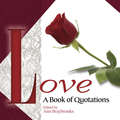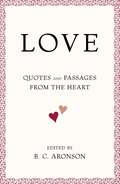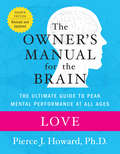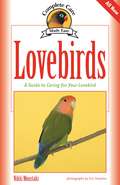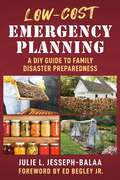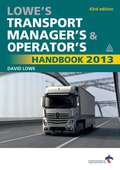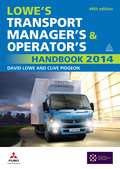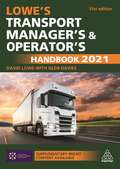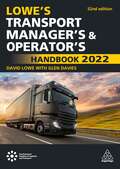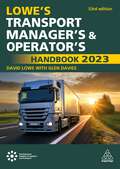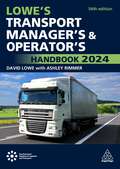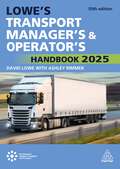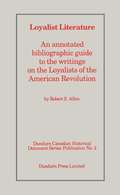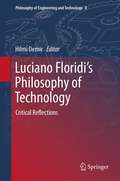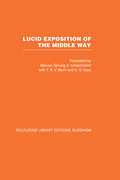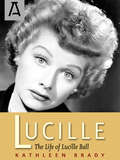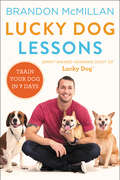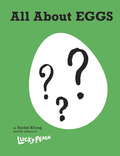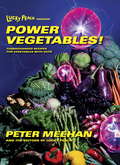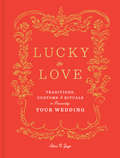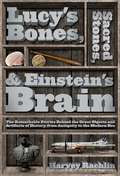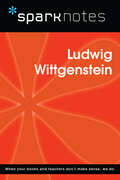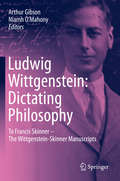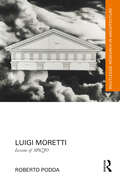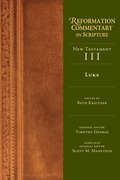- Table View
- List View
Love: A Book of Quotations
by Ann Braybrooks"A heart set on love will do no wrong," declared Confucius. This compact gift book features an international assortment of romantic ruminations from ancient and modern philosophers, playwrights, poets, novelists, commentators, critics, and actors, from Ovid to D. H. Lawrence. Wise, worldly, sentimental, and cynical, the quotes will touch hearts all year long.
Love: Quotes and Passages from the Heart
by B. C. AronsonWhether it's the love we feel for our parents, our significant others, or even our pets, this treasury of over 400 quotes and passages offers us a wonderfully diverse way to discover the meaning of love for ourselves. "True love is like ghosts, which everybody talks about and few have seen. " Francois, Duc de La Rochefoucauld, Writer "If you sweep a house, and tend its fires and fill its stove, and there is love in you all the years you are doing this, then you and that house are married, that house is ...
Love: The Owner's Manual
by Pierce HowardCutting-edge, user-friendly, and comprehensive: the revolutionary guide to the brain, now fully revised and updatedAt birth each of us is given the most powerful and complex tool of all time: the human brain. And yet, as we well know, it doesn't come with an owner's manual--until now. In this unsurpassed resource, Dr. Pierce J. Howard and his team distill the very latest research and clearly explain the practical, real-world applications to our daily lives. Drawing from the frontiers of psychology, neurobiology, and cognitive science, yet organized and written for maximum usability, The Owner's Manual for the Brain, Fourth Edition, is your comprehensive guide to optimum mental performance and well-being. It should be on every thinking person's bookshelf. What are the ingredients of happiness? Which are the best remedies for headaches and migraines? How can we master creativity, focus, decision making, and willpower? What are the best brain foods? How is it possible to boost memory and intelligence? What is the secret to getting a good night's sleep? How can you positively manage depression, anxiety, addiction, and other disorders? What is the impact of nutrition, stress, and exercise on the brain? Is personality hard-wired or fluid? What are the best strategies when recovering from trauma and loss? How do moods and emotions interact? What is the ideal learning environment for children? How do love, humor, music, friendship, and nature contribute to well-being? Are there ways of reducing negative traits such as aggression, short-temperedness, or irritability? What is the recommended treatment for concussions? Can you delay or prevent Alzheimer's and dementia? What are the most important ingredients to a successful marriage and family? What do the world's most effective managers know about leadership, motivation, and persuasion? Plus 1,000s more topics!
Lovebirds
by Nikki Moustaki Eric IlasenkoAuthor Nikki Moustaki certainly cannot resist the splendid lovebird, and her valentine to this irresistible avian wonder is the subject of this Complete Care Made Easy pet guide. This colorful guide offers vital information to both new and experienced bird keepers about this hookbilled parrot, covering all aspects of selecting, caring for, and maintaining well-behaved happy pet birds.Bird specialist and trainer Moustaki has written an ideal introductory pet guide about lovebirds with chapters on the history and characteristics of lovebirds, selection of a healthy, typical pet bird, housing and care, feeding, training, and health care.The chapter "A Look at Lovebird Species" gives readers a glimpse into all nine species. Although nine species exist--ranging from red faced to black collared lovebirds -only the peach-faced, black-masked, and Fischer's are widely available to pet owners.The selection chapter offers potential owners excellent advice about the three main species of lovebirds and how to select the best one from those available commercially.In the chapter on housing and care, the author discusses selection of the right cage, placement of the cage, and all the necessary accessories. A bird's diet is critical to its ongoing health, and the chapter devoted to feeding gives the reader all the info he or she needs about choosing a proper diet for the lovebird . The final two chapters of the book will be useful for bird fanciers interested in learning more about the breeding and the basic color variations and genetics of this beautiful small parrot. The book concludes with an appendix of bird societies, a glossary of terms, and a complete index.
Low-Cost Emergency Planning: A DIY Guide to Family Disaster Preparedness
by Julie L. Jesseph-BalaaA Guide to Family Emergency Readiness That Doesn&’t Break the Bank It is easy to think that you need a small fortune to make plans and stock up for emergency situations. But this book offers an alternative: that families don&’t need to spend their entire savings to be prepared. A solid plan––combined with common sense habits––can use your family&’s day-to-day lifestyle choices to enhance your survival quotient. In Low-Cost Emergency Planning, learn how to develop practices and repurpose everyday household discards to improve your family&’s readiness for natural and human-made disasters. This book offers advice on the basics, from water and food to hygiene and energy alternatives, with full-color photos and clear instructions. By focusing on sustainable habits and DIY resources for basic household necessities, families can be prepared for anything.
Lowe's Transport Manager's and Operator's Handbook 2013
by David LoweThis best-seller for busy fleet operators, now in its 43rd edition, provides essential information and advice on transport legislation, technical standards and goods vehicle operations. Lowe's Transport Manager's and Operator's Handbook is a truly comprehensive guide to the legal, operational and environmental factors that are of the utmost importance in today's road transport industry - including professional competence, working times and driving hours rules, speed cameras and penalties, the international road haulage market, and drugs testing for drivers. The Handbook is the essential reference source for any transport manager, fleet operator, owner-driver haulier or student with an involvement in the industry.
Lowe's Transport Manager's and Operator's Handbook 2014
by David Lowe Clive PidgeonThis best-seller for busy fleet operators, now in its 44th edition, provides essential information and advice on transport legislation, technical standards and goods vehicle operations. Lowe's Transport Manager's and Operator's Handbook is a truly comprehensive guide to the legal, operational and environmental factors that are of the utmost importance in today's road transport industry - including professional competence, working times and driving hours rules, speed cameras and penalties, the international road haulage market, and drugs testing for drivers. The Handbook is the essential reference source for any transport manager, fleet operator, owner-driver haulier or student with an involvement in the industry.
Lowe's Transport Manager's and Operator's Handbook 2021
by David LoweSupplementary Brexit Trade and Cooperation Agreement Content Available. See inside first page/back cover of the book for access details. Maintain your understanding of the rules governing road transport operators in the UK, Ireland and Europe to ensure the safe and legal operation of your fleet.Lowe's Transport Manager's and Operator's Handbook 2021 is the complete guide to the operational rules and guidelines governing the UK, Ireland and the EU's road transport operators. Written and designed for transport managers, fleet operators, owner-driver hauliers and those working in the sector, this book contains all the relevant and technical detail required to run a compliant, safe and efficient transport operation.Now in its 51st edition Lowe's Transport Manager's and Operator's Handbook 2021 remains an essential resource to stay informed on the most pressing issues facing the transport industry. It covers all aspects relating to goods vehicles and their operators from vehicle registration, maintenance and load management (including abnormal and dangerous loads) to professional competence, operator training and driver testing. Road traffic law is explained alongside how to ensure safety on the road and at work. Meeting operating standards, keeping up to date with the latest industry changes and complying with the law, all while running sustainable transport operations, has never been simpler with the help of this guide.
Lowe's Transport Manager's and Operator's Handbook 2022
by David Lowe Glen DaviesThe United Kingdom has experienced the biggest changes to its freight and transport regulations in a lifetime. Understand the complete rules and processes governing the UK's road transport operators with this guide, including those that have changed with Brexit. Lowe's Transport Manager's and Operator's Handbook 2022 offers a complete overview of the operational rules and guidelines governing the UK's road transport operator. This book contains all the relevant legal and technical information required to run a compliant, safe and efficient transport operation. It includes all the latest changes to the rules and processes, including those governing the transportation of goods between Great Britain and the EU following Brexit.This fully updated 52nd edition remains an essential resource for transport managers, fleet operators, owner-driver hauliers and those working in the sector. It covers all aspects relating to goods vehicles and their operators from vehicle registration, maintenance and load management (including abnormal and dangerous loads) to professional competence, operator training and driver testing. Road traffic law is explained alongside how to ensure safety on the road and at work. Meeting operating standards, keeping up to date with the latest industry changes and complying with the law, all while running sustainable transport operations, has never been simpler with the help of this guide.
Lowe's Transport Manager's and Operator's Handbook 2023
by Glen DaviesLowe's Transport Manager's and Operator's Handbook 2023 provides a complete overview of the operational guidance governing the UK's road transport operators.With the uncertainty of technological advancement, post-Brexit trade arrangements and various industry crises, it is essential for the UK's road transport operators to have a firm grasp of the processes, rules and regulations that govern their industry. This fully updated 53rd edition covers all aspects of transport legislation relating to goods vehicles and their operators from vehicle registration, maintenance and load management to professional competence, operator training and driver testing. Road traffic law is explained alongside how to ensure safety on the road and at work.Meeting operating standards, keeping up to date with the latest industry changes and complying with the law, all while running sustainable transport operations, has never been simpler with the help of Lowe's Transport Manager's and Operator's Handbook 2023. It is an essential resource for transport managers, fleet operators, owner driver haulers and those working in the industry looking to ensure operational stability and legislative compliance in a turbulent environment.
Lowe's Transport Manager's and Operator's Handbook 2024
by David LoweLowe's Transport Manager's and Operator's Handbook 2024 offers crucial guidance on changes within the transport and haulage industry, providing a clear and concise approach to complex rules, processes and regulations affecting practitioners within the sector.This fully updated 54th edition outlines important legal and technical information so that transport managers, fleet operators, hauliers and practitioners can ensure they remain compliant while navigating a continuously evolving sector. Covering the latest changes to UK guidelines, this indispensable guide includes an essential overview of new operational rulings, up-to-date regulatory decisions and key aspects of transport legislation. Lowe's Transport Manager's and Operator's Handbook 2024 is a vital source for those wanting to ensure professional competence and operational stability. From driver testing and training, road traffic law and vehicle maintenance to Brexit-led changes and technological advancements, this highly regarded guide remains an essential resource for ensuring the safe and efficient operation of today's transport industry.
Lowe's Transport Manager's and Operator's Handbook 2025
by David Lowe Ashley RimmerThis vital resource offers crucial guidance to complex rules, processes and regulations affecting the transport and haulage industry. Lowe's Transport Manager's and Operator's Handbook 2025 is a vital and respected source for those wanting to ensure professional competence and operational stability. From driver testing and training to road traffic law, this widely used guide remains an essential resource for ensuring the safe and efficient operation of today's transport industry. This fully updated 55th edition outlines important legal and technical information so that transport managers, fleet operators, hauliers and practitioners can ensure they remain compliant while navigating a continuously evolving sector. Covering the latest changes to UK guidelines, this indispensable guide includes an essential overview of new operational rulings, up-to-date regulatory decisions and key aspects of transport legislation.
Loyalist Literature
by Robert S. AllenThis highly readable guide is more than a bibliography. Written in a narrative style, it is as well a short history of the Loyalists: who they were, why they left, where they settled, and what their legacy is.
Luciano Floridi’s Philosophy of Technology
by Hilmi DemirInformation and communication technologies of the 20th century have had a significant impact on our daily lives. They have brought new opportunities as well as new challenges for human development. The Philosopher: Luciano Floridi claims that these new technologies have led to a revolutionary shift in our understanding of humanity's nature and its role in the universe. Florodi's philosophical analysis of new technologies leads to a novel metaphysical framework in which our understanding of the ultimate nature of reality shifts from a materialist one to an informational one. In this world, all entities, be they natural or artificial, are analyzed as informational entities. This book provides critical reflection to this idea, in four different areas: Information Ethics and The Method of Levels of Abstraction The Information Revolution and Alternative Categorizations of Technological Advancements Applications: Education, Internet and Information Science Epistemic and Ontic Aspects of the Philosophy of Information
Lucid Exposition of the Middle Way: The Essential Chapters From The Prasannapada of Candrakirti (Routledge Library Editions: Buddhism)
by Mervyn SprungOriginally published in 1979. The Prasannapada is the explanation of the versed aphorisms of Nagarjuna which are the first and basic statement of the Buddhist philosophy of the middle way. When first published, this volume was the first attempt, in any European language, to present all the essentials of this most radical of Buddhist philosophical works. Seventeen of its twenty-seven chapters have been chosen to give an integrated statement of every aspect of its arguments and conclusions.
Lucille: The Life of Lucille Ball
by Kathleen BradyEveryone loved Lucy, the scheming, madcap redhead who ruled television for more than twenty years. In life, however, Lucille Ball presented a far more complex and contradictory personality than was ever embodied by the television Lucy. In Lucille: The Life of Lucille Ball Kathleen Brady presents the actress as a fully rounded human being, often at odds with the image she presented as an entertainment icon. Brady has gone far beyond the typical celebrity biography to present a funny, unflinching and ultimately moving portrait of Lucille Ball as a performing artist, daughter, mother, friend, colleague, and television mogul. Many think they know the story of Lucille Ball's life, but Brady provides new details and a fresh perspective on this complex woman through a wealth of anecdotes and firsthand accounts. Lucille Ball is revealed not only as a television archetype and influential icon of postwar American culture, but as a driven yet fragile human being who spent her life struggling to create of life of normalcy, but ultimately failed--even as she succeeded in bringing laughter of millions of fans. In researching Lucille, Brady interviewed more than 150 people from her hometown to Hollywood. She spoke with her grade school classmates, and those like Katherine Hepburn and Ginger Rodgers who met her when she arrived in Hollywood in the 1930s. She gained insights from those who knew her before her fame and from those she loved throughout her life. Film, radio and television history come to life with the appearances on these pages of such greats as The Marx Brothers, Buster Keaton, Louis B. Mayer, and of course Desi Arnaz, who march and pratfall through the pages of this outstanding biography.
Lucky Dog Lessons: Train Your Dog in 7 Days
by Brandon McmillanThe celebrity dog trainer and Emmy-winning star of the CBS show Lucky Dog shares his training system to transform any dog--from spoiled purebred puppy to shelter-shocked rescue--into a model companion in just seven days.Each week on Lucky Dog, Brandon McMillan rescues an untrained, unwanted, "unadoptable" shelter dog. In the days that follow, these dogs undergo a miraculous transformation as they learn to trust McMillan, master his 7 Common Commands, and overcome their behavior problems--ultimately becoming well-mannered pets and even service dogs. With his labor of love complete, McMillan unites each dog with a forever family. Now, in his first book, McMillan shares the knowledge he has gained working with thousands of dogs of every breed and personality to help readers turn their own pets into well-trained Lucky Dog graduates. Lucky Dog Lessons begins with the basics--building trust, establishing focus and control, and mastering training techniques. From there, McMillan explains his playful, careful, and kind approach to training the 7 Common Commands he teaches every dog: SIT, STAY, DOWN, COME, OFF, HEEL, and NO. Next, McMillan provides solutions to common canine behavior problems, including house training issues, door dashing, chewing, barking, and common mealtime misbehaviors. Lucky Dog Lessons includes easy-to-follow steps, illustrative examples, tried-and-true tips and tricks, and photographs to demonstrate each technique. Throughout the book, McMillan shares inspiring stories about his favorite students and gives fans a behind-the-scenes look at the show and some of his most unique and challenging canine encounters, including some never-before-seen outtakes.Brandon McMillian believes that no dog is beyond saving, and the loving, positive, successful methods he offers will work wonders with even the most challenging dog. Create the happy pet family you want with Lucky Dog Lessons.
Lucky Peach All About Eggs: Everything We Know About the World's Most Important Food
by the editors of Lucky Peach Rachel KhongA handbook, a cookbook, an eggbook: this quasi-encyclopedic ovarian overview is the only tome you need to own about the indispensable egg. Eggs: star of the most important meal of the day, and, to hear billions of cooks and chefs tell it, quite possibly the world's most important food. Does that make Lucky Peach's All About Eggs the world's most important book? Probably yes. In essays, anecdotes, how-tos, and foolproof recipes, this egg-centric volume celebrates everything an egg can be and do. Whether illuminating the progress of an egg through a chicken, or teaching you how to poach the perfect egg, All About Eggs bursts with facts to deploy at your next cocktail party—then serves up a killer deviled egg recipe to serve while you’re doing it. All About Eggs is for anyone who has ever delighted in the pleasures of an omelet, marveled at the snowflake patterns on a century egg, or longed to make a sky-high soufflé.From the Hardcover edition.
Lucky Peach Presents Power Vegetables!: Turbocharged Recipes for Vegetables with Guts
by the editors of Lucky Peach Peter MeehanMostly vegetarian and infrequently vegan, the recipes in Lucky Peach Presents Power Vegetables! are all indubitably delicious. The editors of Lucky Peach have colluded to bring you a portfolio of meat-free cooking that even carnivores can get behind. Designed to bring BIG-LEAGUE FLAVOR to your WEEKNIGHT COOKING, this collection of recipes, developed by the Lucky Peach test kitchen and chef friends, features trusted strategies for adding oomph to produce with flavors that will muscle meat out of the picture.From the Hardcover edition.
Lucky in Love: Traditions, Customs, and Rituals to Personalize Your Wedding
by Eleni N. GageEvery engaged couple wants two things: a meaningful wedding and a lifetime of happiness. This great gift book is a cross-cultural collection of marriage folklore that will help you achieve both. Create your own lucky traditions with nods to each other’s heritage, customs from places you’ve visited together, and auspicious rituals that just feel special. Whether you are just engaged or you’re days away from tying the knot, you’ll gain insight every step of the way. With this book as your guide, you can make your own luck in love.
Lucy's Bones, Sacred Stones, & Einstein's Brain: The Remarkable Stories Behind the Great Objects and Artifacts of History, From Antiquity to the Modern Era
by Harvey RachlinLeap across time with bestselling author Harvey Rachlin as he collects over 50 of the most fascinating objects in the world, under one book. The Mounted Hide of Stonewall Jackson's Battle Horse, The Black Obelisk, The Rosetta Stone, George Washington's False Teeth, Vice Admiral Lord Nelson's Uniform Coat, The Elephant Man's Skeleton, and Lincoln's Death Bed are just some of the objects Rachlin explores with wit, pick and an amazing sense of spectacle. Publisher's Weekly calls Lucy's Bone's, Sacred Stones, and Einstein's Brain "entertaining and enlightening." Library Journal declares Rachin's work "fascinating." Parade says it is "detailed and authoritative." It is also intensely moving as Rachlin weaves together seemingly disparate histories into a holistic statement that celebrates human endeavor. This book is not simply wonderful -- it is full of wonder.
Ludwig Wittgenstein (SparkNotes Philosophy Guide)
by SparkNotesLudwig Wittgenstein (SparkNotes Philosophy Guide) Making the reading experience fun! SparkNotes Philosophy Guides are one-stop guides to the great works of philosophy–masterpieces that stand at the foundations of Western thought. Inside each Philosophy Guide you&’ll find insightful overviews of great philosophical works of the Western world.
Ludwig Wittgenstein: To Francis Skinner – The Wittgenstein-Skinner Manuscripts
by Ludwig Wittgenstein Francis SkinnerIn this volume we witness Wittgenstein in the act of composing and experimenting with his new visions in philosophy. The book includes key explanations of the origin and background of these previously unknown manuscripts. It investigates how Wittgenstein’s philosophical thought-processes are revealed in his dictation to, as well as his editing and revision with Francis Skinner, in the latter’s role of amanuensis. The book displays a considerable wealth and variety of Wittgenstein’s fundamental experiments in philosophy across a wide array of subjects that include the mind, pure and applied mathematics, metaphysics, the identities of ordinary and creative language, as well as intractable problems in logic and life. He also periodically engages with the work of Newton, Fermat, Russell and others. The book shows Wittgenstein strongly battling against the limits of understanding and the bewitchment of institutional and linguistic customs. The reader is drawn in by Wittgenstein as he urges us to join him in his struggles to equip us with skills, so that we can embark on devising new pathways beyond confusion. This collection of manuscripts was posted off by Wittgenstein to be considered for publication during World War 2, in October 1941. None of it was published and it remained hidden for over two generations. Upon its rediscovery, Professor Gibson was invited to research, prepare and edit the Archive to appear as this book, encouraged by Trinity College Cambridge and The Mathematical Association. Niamh O’Mahony joined him in co-editing and bringing this book to publication.
Luigi Moretti: Lessons of SPAZIO (Routledge Research in Architecture)
by Roberto PoddaLuigi Moretti: Lessons of SPAZIO focuses on the theoretical work of the Italian architect Luigi Moretti (Rome, 1906–1973). It does so selectively, focusing on the editorials he published between 1950 and 1953 as editor-in-chief of the magazine SPAZIO, as well as a further essay on parametric architecture, published in 1971–1972, in the first issue of the magazine MOEBIUS, directed by his friend Giulio Roisecco.This book rediscovers Moretti's personal impact on international architectural theory through thoughtful comments that shed light on the architect's modernity and original approach. Although Moretti is an architect renowned for his projects and buildings, his theoretical essays are less well-known. The aim of this book is therefore to explore Moretti's theoretical work, which covers many topics, including pictorial art, sculpture, architecture, urban planning, music, cinema, poetry, mathematics, computer science, parametricity. In addition to the translation from Italian to English, the book contains reproductions of the original articles, accompanied by a series of essays of critical commentary and updated interpretations that show new ways of approaching, reading, and understanding the foundations of current architectural theory and its progress over the last 50 years. This book approaches Moretti's thought from a new perspective, with the aim of reconsidering the originality of this brilliant and visionary architect who was intellectually ostracised for many years due to political and ideological contingencies, even though he personified the ideal of the 'Renaissance man' in modern times.A re-reading of Moretti's work is more justified today than has ever been before, both to reconnect the threads with contemporaneity and to make his intensity and farsightedness of vision known to researchers, teachers, and students working in the areas of architecture and design theory, technology, and art today.
Luke (Reformation Commentary on Scripture Series #3)
by Beth Kreitzer"For unto you is born this day in the city of David a Savior, who is Christ the Lord." Reflecting on this verse from the Gospel of Luke (2:11), Martin Luther declared it to be a summary of the gospel: "See here what the gospel is, namely, a joyful sermon about Christ our Savior. Whoever preaches him rightly preaches the gospel and pure joy." Reformation commentators meditated upon the significance of the good news of Jesus Christ during a vibrant era in the history of the church that was characterized by spiritual renewal and reform, doctrinal controversy (especially over matters such as the presence of Christ in the Lord's Supper) and the overriding desire to understand the meaning and implications of Scripture for Christian belief and practice. While in many ways similar to the other Synoptic Gospels, the Gospel of Luke also testified to this good news through unique material, including the announcement of Jesus' birth to the shepherds in the fields, the parable of the prodigal son and Jesus' appearance to his disciples on the road to Emmaus after his resurrection. In this volume, Beth Kreitzer skillfully leads readers through the rich diversity of Reformation commentary on the Gospel of Luke. Readers will be able to listen to both well-known and lesser-known voices from a variety of theological traditions, including Lutherans, Reformed, Radicals, Anglicans and Roman Catholics, many of whose comments appear for the first time in English. By drawing from an array of Reformation resources - including commentaries, sermons, treatises and confessions - this volume will equip scholars to understand better the depth and breadth of Reformation commentary, and it will provide contemporary preachers with resources from those in the Reformation church who sought to understand the meaning of this "good news of great joy" (2:10).
